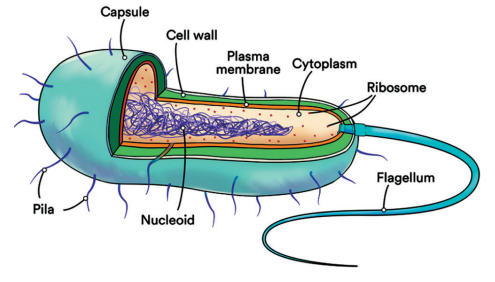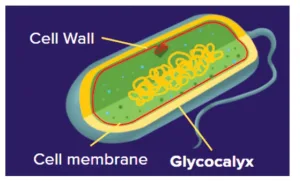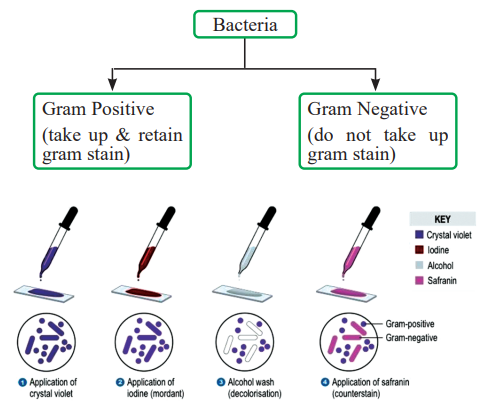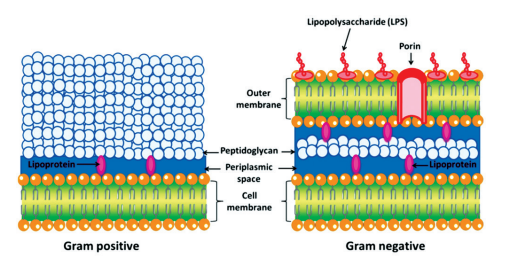
Cell Envelope: The cell envelope is made up of the cell membrane, the cell wall, and, if present, the outer membrane. This envelope is typically found in prokaryotes such as bacteria and consists of the inner cell wall and the bacterium's outer structure. The cell envelope serves an important structural role in the cell. It protects prokaryotes from internal turgor pressure caused by their high macromolecule concentration. Bacterial cell envelopes can be divided into Gram-positive and Gram-negative cell walls. For NEET aspirants, the following article will detail the cell envelope and its constituents.
What is Cell Envelope?
The bacterial cell envelope acts as a protective barrier, shielding the cell from the outside environment. Scientists have used the Gram-staining technique for over a century to classify bacteria based on how they react to specific dyes. This method classifies bacteria into two types: Gram positive, which retains the stain, and Gram negative, which does not.
However, bacterial classification goes beyond staining properties. Prokaryotes are now classified into 30 Bacteria and 5 Archaea phyla based on factors other than staining behavior. Advances in genetic research have altered our understanding of bacterial phylogeny, emphasizing the importance of envelope composition and cell structure.
Bacterial envelopes are now classified according to the number of membranes they contain: diderms have two membranes, whereas monoderms have one. The presence or absence of lipopolysaccharides (LPS) in diderm envelopes is also important for classification.
This chapter provides an overview of recent research into the composition and structure of bacterial cell envelopes. It emphasizes the variety of envelope structures that all work toward the same goal of bacterial survival and protection in their environment.

Cell Envelope Components
The protective layers that surround bacterial cells are essential for maintaining cell structure and function. These layers include:
- Glycocalyx: As the outermost layer, the glycocalyx protects the bacterial cell and promotes adhesion. It exists in two forms:
- Slime Layer: A loose, gelatinous sheath that shields the cell from material leakage, such as water and nutrients.
- Capsule: A thick and tough layer composed of polysaccharides and proteins, providing protection against desiccation, antibiotics, and viral attacks. Additionally, it promotes the formation of bacterial colonies and enhances virulence.
- Cell Function: The cell wall, located between the glycocalyx and the cell membrane, is the middle layer of the cell envelope in prokaryotes . It is primarily made up of peptidoglycan, with some bacteria containing teichoic acid in their cell walls. The cell wall's primary functions include keeping the cell shape, providing structural support, and preventing cell bursting.
- Cell Membrane: The cell membrane, which serves as the innermost layer of the cell envelope, controls the movement of molecules into and out of the cell. It is semi-fluid and selectively permeable; it lacks sterols such as cholesterol but may contain stabilizing molecules known as hopanoids. The cell membrane, which is made up of lipoproteins and membrane proteins, also acts as a respiratory membrane in prokaryotes, housing respiratory enzymes.
- Mesosomes: These are specialized structures formed by the cell membrane as a result of invaginations. Mesosomes contribute to a variety of cellular functions, including cell wall formation, DNA replication, and respiration.
- Chromatophores: These are membrane-bound extensions that contain pigment molecules like bacteriochlorophyll. They are primarily found in photosynthetic bacteria like cyanobacteria. Chromatophores aid in photosynthesis and come in a variety of shapes, including lamellar, tubular, and vesicular.

Cell Envelope Classification
The composition and function of the cell envelope vary among bacterial species. Bacteria can be categorized based on the different types of cell envelopes they possess. Bacteria are classified into two types based on a method known as gram staining.

Gram Positive Bacteria
These bacteria have a strong outer layer of peptidoglycan, like a protective shield that keeps the purple dye from leaking out during gram staining. They also have some special acids, one of which is called teichoic acid, which gives them a negative charge. Teichoic acid bonds with certain molecules, making them negatively charged.
Gram Negative Bacteria
These bacteria have a thinner peptidoglycan layer compared to gram-positive ones. Because of this, the purple dye used in gram staining can easily wash away from them. Instead of teichoic acid, they have lipopolysaccharides, which also give them a negative charge. These lipopolysaccharides help protect them from certain drugs.

Mycobacteria
Aside from the two main types, there is another type of bacteria known as mycobacteria. These bacteria differ from gram-negative bacteria because they lack an outer membrane. Instead, they have a unique cell wall composed of arabinogalactan, peptidoglycan, and mycolic acid. This distinctive cell wall serves as a strong barrier around them.
Cell Envelope Functions
Bacterial cell envelopes serve several important functions that aid in their survival and growth:
- Shape and Structural Integrity: The cell envelope shapes the bacterial cell and provides structural support. This is mainly due to a large peptidoglycan polymer forming a rigid skeleton within the cell envelope. Peptidoglycan helps maintain the cell's shape and structure.
- Nutrient Transport: The cell envelope is essential in transporting nutrients from the surrounding environment into the bacterial cell. It acts as a gateway, allowing essential nutrients to enter the cell and waste products to exit.
- Environmental Protection: Keeping the bacterial cell safe from the harsh and frequently unpredictable outside world is one of the main roles of the cell envelope. It serves as a defence barrier, keeping out dangerous materials and shielding the cell from external stresses.
- Chemical Reaction Surface: The cell envelope of many bacteria acts as a surface for a variety of chemical reactions. This includes processes required for the metabolism and growth of the bacterial cell.
- Flagella Formation: The cell envelope helps motile bacteria form flagella, which are whip-like appendages that allow bacteria to move. Flagella play an important role in bacterial locomotion and navigation to favorable environments.
- Adhesion and Biofilm Production: The outermost layer of the cell envelope, known as the S-layer, helps Gram-positive bacteria adhere to surfaces and form biofilms. Biofilms are bacterial communities enclosed in an extracellular matrix, increasing bacterial survival and resistance to environmental stresses.
- Capsule Formation for Protection: The cell envelope may form a protective capsule in some bacteria. This capsule allows the bacteria to avoid detection and destruction by the host's immune system, particularly phagocytic cells that engulf and destroy foreign invaders.
Overall, the cell envelope is a multifunctional bacteria structure that helps maintain cell integrity, facilitates nutrient uptake, protects against environmental threats, allows movement, and promotes interactions with other cells and surfaces.
Physics Wallah offers NEET Online Coaching students, covering essential concepts needed for exam preparation. Physics Wallah provides top-tier NEET Online Coaching in India at competitive prices. PW NEET courses cover the entire 11th board and NEET exams syllabus. The classes are held as per a schedule and include live sessions twice daily. Class PDF notes are uploaded to the app for easy access.
| NEET Exam Important Links | |
|---|---|
| NEET Biology Syllabus | NEET Biology Diagrams |
| NEET Biology MCQ | NEET Biology Chapter wise Weightage |
| NEET Biology Notes | NEET Previous Year Question papers |
Cell Envelope FAQs
What is the number of different types of cell envelopes?
What is the function and composition of the cell envelope?
What are the components of prokaryotic cell envelopes?
What is the link between the glycocalyx and the cell envelope?
Where is the cell envelope situated?










